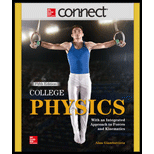
(a)
The velocity of the satellite at the point C.
(a)
Answer to Problem 90P
The velocity of the satellite at the point C is
Explanation of Solution
Write the expression for velocity of the satellite.
Here,
Conclusion:
Substitute
Therefore, the velocity of the satellite at the point C is
(b)
The average velocity of the satellite for one quarter of an orbit starts at point A to the end point B.
(b)
Answer to Problem 90P
The average velocity of the satellite for one quarter of an orbit starts at point A to the end point B is
Explanation of Solution
Write the expression for average velocity of the satellite.
Here,
Substitute
Conclusion:
Substitute
Therefore, the angle does the wheel rotate during the third
(c)
The average acceleration of the satellite for one quarter of an orbit starts at point A to the end point B.
(c)
Answer to Problem 90P
The average acceleration of the satellite for one quarter of an orbit starts at point A to the end point B is
Explanation of Solution
Write the expression for average acceleration of the satellite.
Here,
Since, the average acceleration is in the same direction as,
Substitute
Conclusion:
Substitute
Therefore, the average acceleration of the satellite for one quarter of an orbit starts at point A to the end point B is
(d)
The acceleration of the satellite at point D.
(d)
Answer to Problem 90P
The acceleration of the satellite at point D is
Explanation of Solution
Write the expression for gravitational force.
Here,
Write the expression from Newton’s second law.
Here,
Conclusion:
Solve the equation (IV) and (V) to find centripetal acceleration.
Substitute
Therefore, the acceleration of the satellite at point D is
Want to see more full solutions like this?
Chapter 5 Solutions
COLLEGE PHYSICS-CONNECT ACCESS
- Pls help ASAParrow_forwardFind the integral expression for the magnetic force on a wire carrying 3.5 amps current on the z axis with length2 meters on end at the origin and the other at z=4. Magnetic field is B = 4(zy+4) i - (z-3) j + 20(x+2)/(z-3) k.Don’t take the integral. Integral should contain only x-y-z as variables not rarrow_forwardPls help ASAParrow_forward
- 9. Light of wavelength 442 nm is sent through a single slit with a width of 884 nm. At what angle does the first dark fringe occur? a. 30.0° b. 45.0° C. 60.0° d. 90.0° 10. Light travels through a single-slit and forms an interference pattern. The spacing of the dark fringes on one side of the pattern is 1.44 cm. What is the width of the central maximum? a. 0.720 cm 1.44 cm b. C. 2.88 cm d. 4.32 cmarrow_forwardPls help ASAParrow_forwardd. when the index of refraction of medium A is equal to the index of refraction of medium B 7. What is the term for the bending of a wave front as it passes an obstacle? a. interference b. reflection C. d. diffraction refraction 8. A ray of light travels from air into a soap film on a layer of glass, as shown right. Which statement about ray 1 is true? a. There is no inversion at either surface. b. There is an inversion the surface between air and soap, but not soap and glass. C. There is no inversion at the surface between air and soap, incident light ray 1 ray 2 ray 3 but there is one at the surface between soap and glass. d. There is an inversion at both surfaces. air = nair 1.00 soap film nfilm = 1.35 glass = nglass 1.50arrow_forward
- A circular wire with radius 0.4 meters in on x-y plane. There is a constant Magnetic field with 14T strengthtowards z-axis. Find the magnitude of the electromotive force and the direction of the current for a) B decreasesto 10T in 5 seconds. B) B is rotated by 45 degrees and the area doubles in 4 seconds.arrow_forwardWrite the expression for the magnetic flux inside a region om x-z plane at y=0 bounded by z=3x z=0 x=5 x=7due to a magnetic field B = f(x,y,z) i +g(x,y,z) j + h(x,y,z) karrow_forwardExplain mutual inductance of two loops facing one another and compare with one loop inside the other.arrow_forward
- Two very long wires carry each 3 amps current in the same direction along the z-axis (outward). First is at x=0y=0 current is upward. Second at x=0 y=3 current is also upward. Find the net magnetic field at x=4 y=3.arrow_forwardFind the integral expression for the magnetic field at x=5 y=6 due to a wire on the x axis with length 5 meters onend at x=0 and the other at x=5. Don’t take the integralarrow_forwardTwo very long wires carry current along y-axis. First is at x=0 0.45 amps current is upward. Second at x=5 currentwith 0.65 amps current downward. Find the net magnetic a) Two meters to the left of the first wire. b) Twometers to the right of the first wire. a) Two meters to the right of the second wire. b) Two meters to the right ofthe second wire.arrow_forward
 College PhysicsPhysicsISBN:9781305952300Author:Raymond A. Serway, Chris VuillePublisher:Cengage Learning
College PhysicsPhysicsISBN:9781305952300Author:Raymond A. Serway, Chris VuillePublisher:Cengage Learning University Physics (14th Edition)PhysicsISBN:9780133969290Author:Hugh D. Young, Roger A. FreedmanPublisher:PEARSON
University Physics (14th Edition)PhysicsISBN:9780133969290Author:Hugh D. Young, Roger A. FreedmanPublisher:PEARSON Introduction To Quantum MechanicsPhysicsISBN:9781107189638Author:Griffiths, David J., Schroeter, Darrell F.Publisher:Cambridge University Press
Introduction To Quantum MechanicsPhysicsISBN:9781107189638Author:Griffiths, David J., Schroeter, Darrell F.Publisher:Cambridge University Press Physics for Scientists and EngineersPhysicsISBN:9781337553278Author:Raymond A. Serway, John W. JewettPublisher:Cengage Learning
Physics for Scientists and EngineersPhysicsISBN:9781337553278Author:Raymond A. Serway, John W. JewettPublisher:Cengage Learning Lecture- Tutorials for Introductory AstronomyPhysicsISBN:9780321820464Author:Edward E. Prather, Tim P. Slater, Jeff P. Adams, Gina BrissendenPublisher:Addison-Wesley
Lecture- Tutorials for Introductory AstronomyPhysicsISBN:9780321820464Author:Edward E. Prather, Tim P. Slater, Jeff P. Adams, Gina BrissendenPublisher:Addison-Wesley College Physics: A Strategic Approach (4th Editio...PhysicsISBN:9780134609034Author:Randall D. Knight (Professor Emeritus), Brian Jones, Stuart FieldPublisher:PEARSON
College Physics: A Strategic Approach (4th Editio...PhysicsISBN:9780134609034Author:Randall D. Knight (Professor Emeritus), Brian Jones, Stuart FieldPublisher:PEARSON





